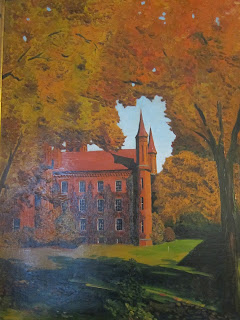Johnston Hall the remaining Limestone building on the Seabury Seminary Campus in Faribault, served the Episcopal Church for many years. Grateful I could donate a walnut bookcase, once housed in this buildings library, built in 1888, to the Cathedral of Our Merciful Savior. On the national register of historic places, this building is once again (after 1986, was used to house clinics etc) threatened to be demolished by the District One Hospital Board's inaction to put on a roof. There is a meeting of the Faribault City Council March 5th, 2013 at 6 PM to see if the mayor, John Jasinski and others can lend their support to integrate this building into the Campus of District One Health Center.
For the history of Seabury, that left Faribault in 1933 see
http://seabury.edu/history/history-seabury-western-theological-seminary.html
: Seabury-Western Theological Seminary was created in 1933 by the merger of Seabury Divinity School (1858, Faribault, Minnesota) and Western Theological Seminary (1883, Chicago, Illinois).
In 1858, James Lloyd Breck founded Bishop Seabury University in Faribault, Minnesota, to provide education from primary school through theological studies for both Native Americans and Euro-American settlers. He envisioned his “School of the Prophets” as the center of evangelism for the about-to-be organized Diocese of Minnesota. The Seabury Divinity School, which emerged, continued its missionary consciousness and, in the twentieth century, developed a distinctly evangelical character.
- See more at: http://seabury.edu/history/history-seabury-western-theological-seminary.html#sthash.iTd2wvSC.dpuf
Victor Pinkham, a graduate of Seabury, taught at Seabury Divinity School until it moved to Chicago. Completing his PhD at Harvard in the 30's, his only child, Winifred Elaine Pinkham Leonard, remained with her grandparents, the Jenkins, who taught at St James School, graduating in 1940. The Pinkhams moved to Northfield where Victor taught history at Carleton College and was the rector of All Saints Episcopal. FE Jenkins, first headmaster of St James, purchased land on the SE Shore of Pelican Lake in 1906, and envisioned a boys camp there that is found on the 1920's map of the area.
District One Hospital was built in Faribault on the old Seabury Campus. Here are Dr Burton Orr, General Surgeon on the left with my father, Paul H Weaver MD, General Practice in the surgical suite perhaps even at St Lucas Deaconess Hospital before District One was built. I remember that dad left early for "8 o'clock" surgery on the east side of Faribault where the hospital was.
Keeping with the thread of Educators of the Shattuck, St James Schools and Seabury with Pelican Lake, John A Foster and Fredrick Haeberle are two key figures. They founded a real estate company in Faribault early in the 1900's and later platted Sunset Beach along with SE shore of Pelican Lake, Crow Wing County.
This map circa 1920, was found in the cabin purchased by the three Weaver brothers from Faribault, Jim, Jack and Tom (this author) in 1967, shows area of red markings, Sunset Beach my Lake Marquis and Shattuck Camp NW of Lougee Lake. On the back of this maps was the label:
In Dec 1913, according to the Faribault Republican, The Home and Loan Company, was incorporated by JA Foster and FL Haeberle and Frank W Ferris who entered the business of platting land, building and selling homes in Faribault.
Fred Haeberle taught business at Shatuck School from 1904-1937. He and John Foster were involved in platting Sunset Beach On Pelican Lake in 1920.
Having built a cabin centered around an ice house brought across the lake on ice during WWI, here are Bernice and John Foster in 1959, taken behind their cabin on Lot 14, Sunset Beach.
The second cabin built on the SE Shore of Pelican, likely is this one, built in 1913 by FE Jenkins. This photo was recently discovered by his great grandson, Jim Leonard, who now lives permanently in the Pelican Lake area.
This 1914 photo labeled with the assistance of Winnie Leonard (Winifred E Pinkham Leonard) , includes Fred Haeberle, FE Jenkins and Rev Levering, who all worked in Faribault with the Episcopal schools. Levering was the chaplain at Shattuck. Looks to me like some wrapped fish, ready to be smoked...What do you think? Comments welcome.
In mid October of this year, Jim Leonard who lives on the property purchased through his great grandfather FE Jenkins, sent this photo to the Weaver Family. Jim Weaver, now owner of the century old Haeberle Cabin, had arranged for a new road built to allow fire fighter access with the current truck specifications to serve cabins on the shore. Here is the Haerberle Way sign for the road intersecting with Pelican Lake Road in the woods behind the cabins.
And Haeberle Way at the intersection with Leonard Road at the other end of the road.
Last evening, Oct 23, 2014 I met the archvist at Shattuck School, Lonnie Schroeder, who spoke about the history and relationship of Shattuck-St Mary's with the city of Faribault. Perhaps she has other information about the life and history of Fred Haeberle to share for future generations. I am sending her the link to this page and plan to visit Faribault this year planning for my 50th High School Reunion in mid August 2015! :-)
Last evening, Oct 23, 2014 I met the archvist at Shattuck School, Lonnie Schroeder, who spoke about the history and relationship of Shattuck-St Mary's with the city of Faribault. Perhaps she has other information about the life and history of Fred Haeberle to share for future generations. I am sending her the link to this page and plan to visit Faribault this year planning for my 50th High School Reunion in mid August 2015! :-)






cropped.jpg)
















